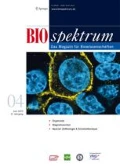Abstract
Climate change and the finite nature of fossil fuels raise the need for the fixation of CO2 and conversion into traditionally petroleum-derived chemicals. With Cupriavidus necator as an easily genetically modifiable biocatalyst, a wide range of products, e. g. polymers, platform chemicals, biofuels, and terpenes, can be accessed. The wide range of applications as well as a prominent example of electrochemical α-humulene production from CO2 are promising developments towards a bio-based society.
Similar content being viewed by others
Literatur
Sydow A, Krieg T, Mayer F et al. (2014) Electroactive bacteria-molecular mechanisms and genetic tools. Appl Microbiol Biotechnol 98:8481–8495
Heinrich D, Raberg M, Steinbüchel A (2017) Studies on the aerobic utilization of synthesis gas (syngas) by wild type and recombinant strains of Ralstonia eutropha H16. Microb Biotechnol, doi: 10.1111/1751-7915.12873
Ishizaki A, Tanaka K, Taga N (2001) Microbial production of poly-D-3-hydroxybutyrate from CO2. Appl Microbiol Biotechnol 57:6
Raberg M, Voigt B, Hecker M et al. (2014) A closer look on the polyhydroxybutyrate-(PHB-) negative phenotype of Ralstonia eutropha PHB-4. PLoS One 9:1–11
Gruber S, Hagen J, Schwab H et al. (2014) Versatile and stable vectors for efficient gene expression in Ralstonia eutropha H16. J Biotechnol 186:74–82
Sydow A, Pannek A, Krieg T et al. (2017) Expanding the genetic tool box for Cupriavidus necator by a stabilized L-rhamnose inducible plasmid system. J Biotechnol 263:1–10
Tee KL, Grinham J, Othusitse AM et al. (2017) An efficient transformation method for the bioplastic-producing ‘Knallgas’ bacterium Ralstonia eutropha H16. Biotechnol J 12, doi: 10.1002/biot.201700081
Raberg M, Volodina E, Lin K et al. (2017) Ralstonia eutropha H16 in progress: applications beside PHAs and establishment as production platform by advanced genetic tools. Crit Rev Biotechnol 0:1–17
Marc J, Grousseau E, Lombard E et al. (2017) Over-expression of GroESL in Cupriavidus necator for heterotrophic and autotrophic isopropanol production. Metab Eng 42:74–84
Krieg T, Sydow A, Faust S et al. (2018) CO2 to terpenes: autotrophic and electroautotrophic α-humulene production with Cupriavidus necator. Angew Chemie Int Ed 57:1–5
Author information
Authors and Affiliations
Corresponding author
Rights and permissions
About this article
Cite this article
Milker, S., Kunze, C., Sydow, A. et al. Knallgasbakterien – neue Synthesewege mit Cupriavidus necator. Biospektrum 24, 324–326 (2018). https://doi.org/10.1007/s12268-018-0920-y
Published:
Issue Date:
DOI: https://doi.org/10.1007/s12268-018-0920-y



